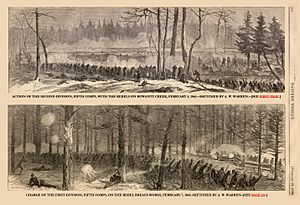Battle of Hatcher's Run facts for kids
Quick facts for kids Battle of Hatcher's Run |
|||||||
|---|---|---|---|---|---|---|---|
| Part of the American Civil War | |||||||
 Actions of the Fifth Corps, February 5–7, 1865 |
|||||||
|
|||||||
| Belligerents | |||||||
| Commanders and leaders | |||||||
| Andrew A. Humphreys Thomas M. Harris Gouverneur K. Warren |
John B. Gordon | ||||||
| Strength | |||||||
| 34,517 | 13,835 | ||||||
| Casualties and losses | |||||||
| 1,539 total (171 killed, 1181 wounded, 187 captured) |
1,161 total | ||||||
The Battle of Hatcher's Run was an important fight during the American Civil War. It happened near Petersburg, Virginia, from February 5 to 7, 1865. This battle was part of a bigger plan by the Union (the North) to cut off supplies to the Confederate (the South) soldiers defending Petersburg. The Union wanted to stop trains and wagons bringing food and supplies to the Confederates. This battle is also known by other names like Dabney's Mill and Armstrong's Mill.
Contents
Why They Fought: The Plan
The Union army was trying to capture Petersburg, Virginia, which was a very important city for the Confederates. To do this, they needed to cut off the roads and railroads that brought supplies to the Confederate soldiers. The Battle of Hatcher's Run was one of these attempts.
The Union plan was simple:
- A group of Union cavalry (soldiers on horseback) led by David McMurtrie Gregg would ride out to a road called Boydton Plank Road. Their job was to find and destroy any Confederate supply wagons.
- At the same time, two large groups of Union soldiers, called the V Corps and II Corps, would support the cavalry. They would keep the Confederates busy and prevent them from stopping the cavalry.
Opposing Forces
Union Army Leaders
The main Union generals involved were Andrew A. Humphreys and Gouverneur K. Warren. They led thousands of Union soldiers.
Confederate Army Leaders
The Confederate forces were led by General John Brown Gordon.
The Battle Unfolds
Day 1: February 5, 1865
On the first day, Union cavalry, led by General Gregg, rode west towards Boydton Plank Road. They were looking for Confederate supply wagons. Meanwhile, the Union V Corps, led by General Warren, moved southwest to protect the cavalry's right side.
Two divisions of the Union II Corps, led by General Humphreys, also moved to cover the Union lines. Later that day, Confederate General John B. Gordon attacked the II Corps. The Union soldiers fought back and stopped the attack. That night, the Union lines were made stronger as more troops arrived.
Day 2: February 6, 1865
On the second day, Confederate soldiers attacked the Union V Corps. The Union troops pushed them back at first. However, a counterattack by Confederate General Clement A. Evans stopped the Union's advance.
Later, more Confederate divisions attacked the center of the Union line near Dabney's Mill. The Union line struggled under the attack and had to move back. During this fighting, Confederate General John Pegram was killed.
Day 3: February 7, 1865
On the third day, General Warren launched a strong attack for the Union. His troops pushed the Confederates back. They managed to take back most of the land around Dabney's Mill that they had lost the day before.
After the Battle
After the battle, the Union army extended their defensive lines closer to Hatcher's Run. The Confederates managed to keep the Boydton Plank Road open for supplies. However, they had to stretch their already thin lines even further to defend it.
Years later, on April 21, 1896, Union assistant surgeon Jacob F. Raub was awarded the Medal of Honor for his brave actions during this battle.
Saving the Battlefield
The Civil War Trust (which is now part of the American Battlefield Trust) and its partners have worked to save parts of the Hatcher's Run battlefield. They have bought and protected about 387 acres (1.56 km²) of the land where the battle took place. This helps make sure these important historical sites are preserved for the future.

